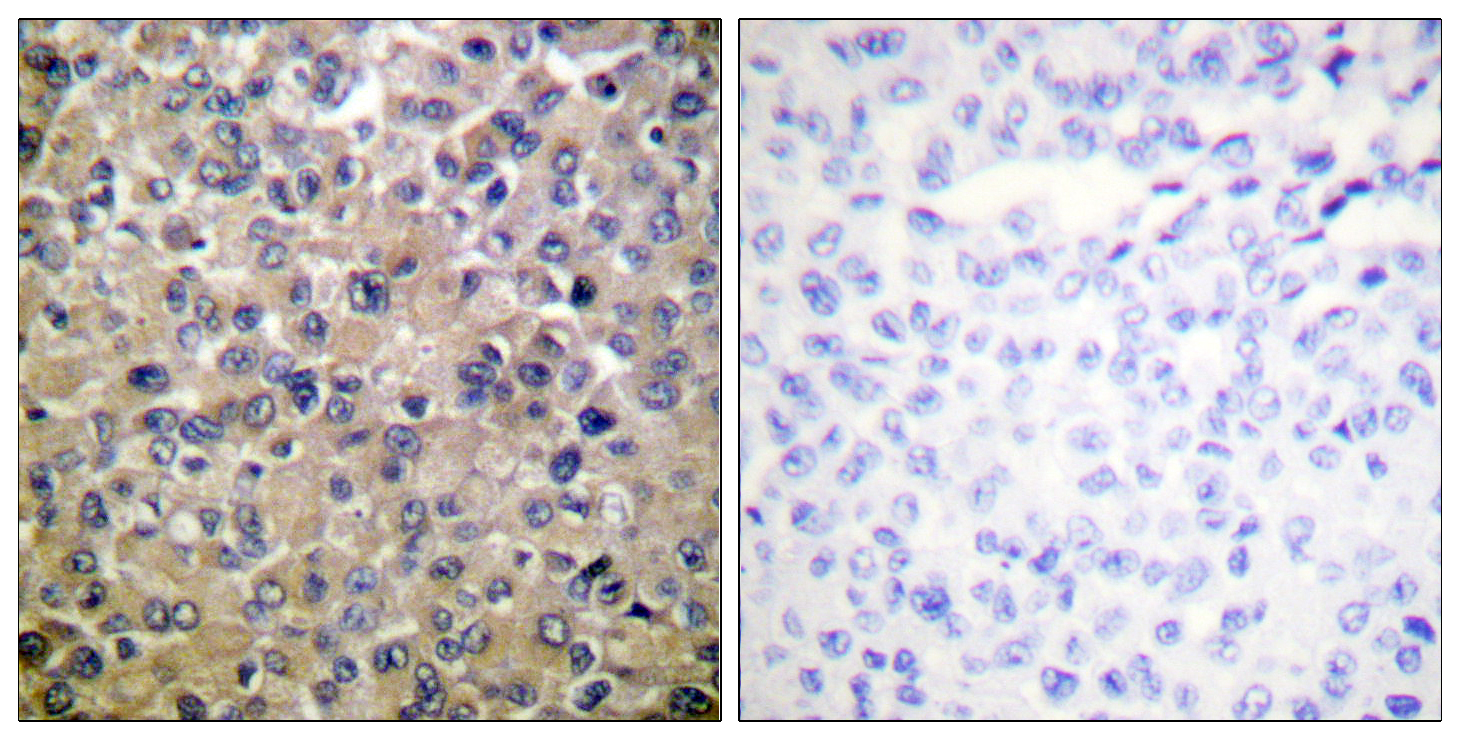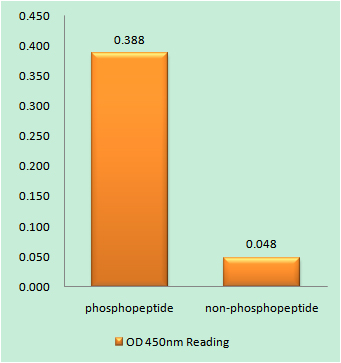
Catalog: YP0974
Size
Price
Status
Qty.
200μL
$600.00
In stock
0
100μL
$340.00
In stock
0
50μL
$190.00
In stock
0
Add to cart


Collected


Collect
Main Information
Target
PP1α
Host Species
Rabbit
Reactivity
Human, Mouse, Rat
Applications
IHC, IF, ELISA
MW
38kD (Calculated)
Conjugate/Modification
Phospho
Detailed Information
Recommended Dilution Ratio
IHC 1:100-1:300; ELISA 1:10000; IF 1:50-200
Formulation
Liquid in PBS containing 50% glycerol, 0.5% BSA and 0.02% sodium azide.
Specificity
Phospho-PP1α (T320) Polyclonal Antibody detects endogenous levels of PP1α protein only when phosphorylated at T320.The name of modified sites may be influenced by many factors, such as species (the modified site was not originally found in human samples) and the change of protein sequence (the previous protein sequence is incomplete, and the protein sequence may be prolonged with the development of protein sequencing technology). When naming, we will use the "numbers" in historical reference to keep the sites consistent with the reports. The antibody binds to the following modification sequence (lowercase letters are modification sites):PItPP
Purification
The antibody was affinity-purified from rabbit antiserum by affinity-chromatography using epitope-specific immunogen.
Storage
-15°C to -25°C/1 year(Do not lower than -25°C)
Concentration
1 mg/ml
MW(Calculated)
38kD
Modification
Phospho
Clonality
Polyclonal
Isotype
IgG
Related Products
Antigen&Target Information
Immunogen:
The antiserum was produced against synthesized peptide derived from human PP1-alpha around the phosphorylation site of Thr320. AA range:281-330
show all
Specificity:
Phospho-PP1α (T320) Polyclonal Antibody detects endogenous levels of PP1α protein only when phosphorylated at T320.The name of modified sites may be influenced by many factors, such as species (the modified site was not originally found in human samples) and the change of protein sequence (the previous protein sequence is incomplete, and the protein sequence may be prolonged with the development of protein sequencing technology). When naming, we will use the "numbers" in historical reference to keep the sites consistent with the reports. The antibody binds to the following modification sequence (lowercase letters are modification sites):PItPP
show all
Gene Name:
PPP1CA
show all
Protein Name:
Serine/threonine-protein phosphatase PP1-alpha catalytic subunit
show all
Other Name:
PPP1CA ;
PPP1A ;
Serine/threonine-protein phosphatase PP1-alpha catalytic subunit ;
PP-1A
PPP1A ;
Serine/threonine-protein phosphatase PP1-alpha catalytic subunit ;
PP-1A
show all
Database Link:
Background:
The protein encoded by this gene is one of the three catalytic subunits of protein phosphatase 1 (PP1). PP1 is a serine/threonine specific protein phosphatase known to be involved in the regulation of a variety of cellular processes, such as cell division, glycogen metabolism, muscle contractility, protein synthesis, and HIV-1 viral transcription. Increased PP1 activity has been observed in the end stage of heart failure. Studies in both human and mice suggest that PP1 is an important regulator of cardiac function. Mouse studies also suggest that PP1 functions as a suppressor of learning and memory. Three alternatively spliced transcript variants encoding different isoforms have been found for this gene. [provided by RefSeq, Jul 2008],
show all
Function:
Catalytic activity:A phosphoprotein + H(2)O = a protein + phosphate.,Caution:The sequence shown here is derived from an Ensembl automatic analysis pipeline and should be considered as preliminary data.,cofactor:Binds 1 iron ion per subunit.,cofactor:Binds 1 manganese ion per subunit.,enzyme regulation:The phosphatase activity of the PPP1R15A-PP1 complex toward EIF2S1 is specifically inhibited by Salubrinal, a drug that protects cells from endoplasmic reticulum stress.,Function:Protein phosphatase 1 (PP1) is essential for cell division, and participates in the regulation of glycogen metabolism, muscle contractility and protein synthesis. Involved in regulation of ionic conductances and long-term synaptic plasticity. May play an important role in dephosphorylating substrates such as the postsynaptic density-associated Ca(2+)/calmodulin dependent protein kinase II.,online information:The things we forget -Issue 32 of March 2003,similarity:Belongs to the PPP phosphatase family.,similarity:Belongs to the PPP phosphatase family. PP-1 subfamily.,subunit:PP1 comprises a catalytic subunit, PPP1CA, PPP1CB or PPP1CC, which is folded into its native form by inhibitor 2 and glycogen synthetase kinase 3, and then complexed to one or several targeting or regulatory subunits. PPP1R12A, PPP1R12B and PPP1R12C mediate binding to myosin. PPP1R3A, PPP1R3B, PPP1R3C and PPP1R3D mediate binding to glycogen. Interacts with PPP1R9A and PPP1R9B. Part of a complex containing PPP1R15B, PP1 and NCK1/2 (By similarity). Interacts with PPP1R7. PPP1R15A and PPP1R15B mediate binding to EIF2S1. Interacts with HHV-1 ICP34.5.,
show all
Cellular Localization:
Cytoplasm . Nucleus . Nucleus, nucleoplasm . Nucleus, nucleolus . Primarily nuclear and largely excluded from the nucleolus. Highly mobile in cells and can be relocalized through interaction with targeting subunits. NOM1 plays a role in targeting this protein to the nucleolus. In the presence of PPP1R8 relocalizes from the nucleus to nuclear speckles. Shuttles toward the cytosol during infection with VEEV (PubMed:29769351). .
show all
Tissue Expression:
Colon carcinoma,Liver,Lung,Muscle,Pancreas,Placenta,Platele
show all
Research Areas:
>>mRNA surveillance pathway ;
>>cGMP-PKG signaling pathway ;
>>cAMP signaling pathway ;
>>Oocyte meiosis ;
>>Cellular senescence ;
>>Adrenergic signaling in cardiomyocytes ;
>>Vascular smooth muscle contraction ;
>>Hippo signaling pathway ;
>>Focal adhesion ;
>>Platelet activation ;
>>Long-term potentiation ;
>>Dopaminergic synapse ;
>>Inflammatory mediator regulation of TRP channels ;
>>Regulation of actin cytoskeleton ;
>>Insulin signaling pathway ;
>>Oxytocin signaling pathway ;
>>Insulin resistance ;
>>Amphetamine addiction ;
>>Alcoholism ;
>>Herpes simplex virus 1 infection ;
>>Proteoglycans in cancer ;
>>Diabetic cardiomyopathy
>>cGMP-PKG signaling pathway ;
>>cAMP signaling pathway ;
>>Oocyte meiosis ;
>>Cellular senescence ;
>>Adrenergic signaling in cardiomyocytes ;
>>Vascular smooth muscle contraction ;
>>Hippo signaling pathway ;
>>Focal adhesion ;
>>Platelet activation ;
>>Long-term potentiation ;
>>Dopaminergic synapse ;
>>Inflammatory mediator regulation of TRP channels ;
>>Regulation of actin cytoskeleton ;
>>Insulin signaling pathway ;
>>Oxytocin signaling pathway ;
>>Insulin resistance ;
>>Amphetamine addiction ;
>>Alcoholism ;
>>Herpes simplex virus 1 infection ;
>>Proteoglycans in cancer ;
>>Diabetic cardiomyopathy
show all
Signaling Pathway
Cellular Processes >> Cell growth and death >> Cellular senescence
Cellular Processes >> Cellular community - eukaryotes >> Focal adhesion
Cellular Processes >> Cell motility >> Regulation of actin cytoskeleton
Organismal Systems >> Immune system >> Platelet activation
Organismal Systems >> Endocrine system >> Insulin signaling pathway
Organismal Systems >> Endocrine system >> Oxytocin signaling pathway
Organismal Systems >> Circulatory system >> Adrenergic signaling in cardiomyocytes
Organismal Systems >> Circulatory system >> Vascular smooth muscle contraction
Organismal Systems >> Nervous system >> Dopaminergic synapse
Organismal Systems >> Sensory system >> Inflammatory mediator regulation of TRP channels
Environmental Information Processing >> Signal transduction >> Hippo signaling pathway
Environmental Information Processing >> Signal transduction >> cAMP signaling pathway
Environmental Information Processing >> Signal transduction >> cGMP-PKG signaling pathway
Reference Citation({{totalcount}})
Catalog: YP0974
Size
Price
Status
Qty.
200μL
$600.00
In stock
0
100μL
$340.00
In stock
0
50μL
$190.00
In stock
0
Add to cart


Collected


Collect
Recently Viewed Products
Clear allPRODUCTS
CUSTOMIZED
ABOUT US
Toggle night Mode
{{pinfoXq.title || ''}}
Catalog: {{pinfoXq.catalog || ''}}
Filter:
All
{{item.name}}
{{pinfo.title}}
-{{pinfo.catalog}}
Main Information
Target
{{pinfo.target}}
Reactivity
{{pinfo.react}}
Applications
{{pinfo.applicat}}
Conjugate/Modification
{{pinfo.coupling}}/{{pinfo.modific}}
MW (kDa)
{{pinfo.mwcalc}}
Host Species
{{pinfo.hostspec}}
Isotype
{{pinfo.isotype}}
Product {{index}}/{{pcount}}
Prev
Next
{{pvTitle}}
Scroll wheel zooms the picture
{{pvDescr}}




















